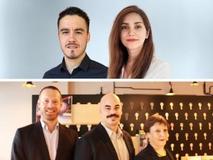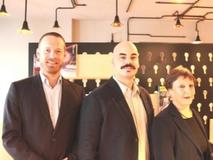CHF 40,000 for multi-tissue systems and textile-integrated tissue oxygenation sensors
15.02.2022
Fluosphera and SensaWear win the second stage of Venture Kick entrepreneurial and financial support. Their projects aim at predicting much better the efficacy and safety of drugs with multi-tissue systems to de-risk drug development and to reduce animal experimentation, and sensors giving the patient feedback about their tissue oxygenation saturation so that they can act to prevent pressure injuries before they happen.
 |
 FluoSphera CEO-CSO Gregory Segala and CTO Marie Shamseddin
|
 SensaWear: CEO Oliver Kress, CTO Tarcisi Cantieni, and interim-CMO Prof. Dr. Ursula Wolf
|
Fluosphera: Multi-tissue systems for a reliable prediction of efficacy and toxicity of drugs
Drug development costs CHF 2.6 billion with a failure rate of 90% because in vitro methods do not recapitulate the systemic organization of the human body. The lack of relevance of current in vitro data dramatically increases drug development failure due to unforeseen toxicity (40% of failure), and unpredicted lack of efficacy (50% of failure). As a result, the limitations of in vitro testing reduce the probability to develop safe and efficient drugs for patients. FluoSphera's team is composed of Dr. Gregory Segala (CEO/CSO, future co-founder), Dr. Marie Shamseddin (CTO, future co-founder), Prof. Aurélien Roux (co-founder and Full Professor at the University of Geneva), Dr. Igor Fisch (Board member, former co-founder and CEO of Selexis), and Dr. Kamel Besseghir (Board Member, former CEO of Debiopharm).
Fluosphera develops in vitro human biosystems (patent WO2021058557A1) that mimic essential features of human body organization: the 3D spatial organization of tissues (spheroids and organoids), and systemic communications between those tissues (multi-tissue system). Based on this technology, FluoSphera proposes R&D services to generate systemic data that predict much better the effects of drugs on patients to de-risk drug development projects. FluoSphera's services can potentially decrease by 2-fold the failure rate of drug development in clinical phase I, thus increasing the number of safe and potent drugs on the market. Up to CHF 200 million/drug can be saved by pharmaceutical companies and re-invested in other therapeutic fields. As an alternative to animal experimentation, FluoSphera's biosystems can reduce the number of animals used for drug discovery.
FluoSphera will use Venture Kick support to further develop and test their R&D offering directly on the market thanks to the employment of an R&D scientist ensuring the execution of the proposed services. FluoSphera will also increase customer attention and awareness of their technology and services by participating in industry conferences, and by improving their marketing communication. fluosphera.com
SensaWear: wearable, textile-integrated tissue oxygenation and pressure sensors using the principle of near-infrared spectroscopy
There currently exist no continuous monitoring methods for the prevention of pressure injuries. Nurses and caretakers have to inspect patients for signs of early stages of pressure injury formation. This can be difficult because most people who form them cannot move, and the injury starts below the skin. By the time the skin shows signs of the injury, the damage is often done and the path to recovery is long, painful, difficult, and expensive.
Prof. Dr. Ursula Wolf from the University of Bern (IKIM) is SensaWear interim-CMO, co-founder, chairwoman of the board, and medical advisor with experience in near-infrared technology, and Dr. Oliver Kress is the CEO and co-founder with a background in physics and a strong desire to commercialize revolutionary technology in the med-tech field. CTO and co-founder Tarcisi Cantieni, M.Sc. (Ph.D. candidate) will direct SensaWear's R&D. SensaWear develops wearable, textile-integrated tissue oxygenation and pressure sensors using the principle of near-infrared spectroscopy. Special fiber optics seamlessly integrated into clothing will give users real-time feedback of their tissue oxygen saturation and pressure against the skin. This will allow the user to be aware of low-oxygenation conditions induced by high-pressure points, indicating they should move or be moved. This technology will prevent painful and dangerous pressure injuries/pressure ulcers from forming. SensaWear is working with industrial partners to produce specialized electronics and textiles and will develop and market the sensors to hospitals and clinics, saving the industry billions of dollars each year. In addition, their technology has also gained interest as an adhesive-based deep-tissue oxygenation monitor for use during surgery and tissue trauma recovery.
They plan to use the money to travel to hospitals throughout Switzerland, Europe, and the US to visit hospitals and attend tradeshows for market validation, brand awareness, and to financially support a CE mark and FDA certification and registration of the medical device; a key milestone needed for timely commercialization. Venture Kick funds will also be used to support clinical data collection, grow their team and help turn their prototypes into commercial products.
Drug development costs CHF 2.6 billion with a failure rate of 90% because in vitro methods do not recapitulate the systemic organization of the human body. The lack of relevance of current in vitro data dramatically increases drug development failure due to unforeseen toxicity (40% of failure), and unpredicted lack of efficacy (50% of failure). As a result, the limitations of in vitro testing reduce the probability to develop safe and efficient drugs for patients. FluoSphera's team is composed of Dr. Gregory Segala (CEO/CSO, future co-founder), Dr. Marie Shamseddin (CTO, future co-founder), Prof. Aurélien Roux (co-founder and Full Professor at the University of Geneva), Dr. Igor Fisch (Board member, former co-founder and CEO of Selexis), and Dr. Kamel Besseghir (Board Member, former CEO of Debiopharm).
Fluosphera develops in vitro human biosystems (patent WO2021058557A1) that mimic essential features of human body organization: the 3D spatial organization of tissues (spheroids and organoids), and systemic communications between those tissues (multi-tissue system). Based on this technology, FluoSphera proposes R&D services to generate systemic data that predict much better the effects of drugs on patients to de-risk drug development projects. FluoSphera's services can potentially decrease by 2-fold the failure rate of drug development in clinical phase I, thus increasing the number of safe and potent drugs on the market. Up to CHF 200 million/drug can be saved by pharmaceutical companies and re-invested in other therapeutic fields. As an alternative to animal experimentation, FluoSphera's biosystems can reduce the number of animals used for drug discovery.
FluoSphera will use Venture Kick support to further develop and test their R&D offering directly on the market thanks to the employment of an R&D scientist ensuring the execution of the proposed services. FluoSphera will also increase customer attention and awareness of their technology and services by participating in industry conferences, and by improving their marketing communication. fluosphera.com
SensaWear: wearable, textile-integrated tissue oxygenation and pressure sensors using the principle of near-infrared spectroscopy
There currently exist no continuous monitoring methods for the prevention of pressure injuries. Nurses and caretakers have to inspect patients for signs of early stages of pressure injury formation. This can be difficult because most people who form them cannot move, and the injury starts below the skin. By the time the skin shows signs of the injury, the damage is often done and the path to recovery is long, painful, difficult, and expensive.
Prof. Dr. Ursula Wolf from the University of Bern (IKIM) is SensaWear interim-CMO, co-founder, chairwoman of the board, and medical advisor with experience in near-infrared technology, and Dr. Oliver Kress is the CEO and co-founder with a background in physics and a strong desire to commercialize revolutionary technology in the med-tech field. CTO and co-founder Tarcisi Cantieni, M.Sc. (Ph.D. candidate) will direct SensaWear's R&D. SensaWear develops wearable, textile-integrated tissue oxygenation and pressure sensors using the principle of near-infrared spectroscopy. Special fiber optics seamlessly integrated into clothing will give users real-time feedback of their tissue oxygen saturation and pressure against the skin. This will allow the user to be aware of low-oxygenation conditions induced by high-pressure points, indicating they should move or be moved. This technology will prevent painful and dangerous pressure injuries/pressure ulcers from forming. SensaWear is working with industrial partners to produce specialized electronics and textiles and will develop and market the sensors to hospitals and clinics, saving the industry billions of dollars each year. In addition, their technology has also gained interest as an adhesive-based deep-tissue oxygenation monitor for use during surgery and tissue trauma recovery.
They plan to use the money to travel to hospitals throughout Switzerland, Europe, and the US to visit hospitals and attend tradeshows for market validation, brand awareness, and to financially support a CE mark and FDA certification and registration of the medical device; a key milestone needed for timely commercialization. Venture Kick funds will also be used to support clinical data collection, grow their team and help turn their prototypes into commercial products.


